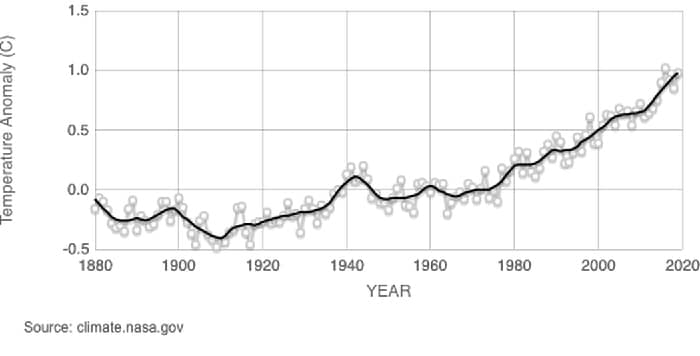Temperatures keep rising, despite COVID-19 emission cuts, and international efforts to comply with the Paris Agreement. 2020 officially tied 2016 as the hottest year on record, since these began in the 1800s. “It’s gotten to the point where these intense heat waves would not be possible in any reasonable amount of time in a non-human-perturbed climate”
– NASA Goddard Institute for Space Studies (GISS) Director Gavin Schmidt (ref. 1).

The 2016-2020 average anomalies of global surface air temperatures relative to the 1951-1980 average, in degrees Fahrenheit. Blue areas are cooler than average and yellow and red are warmer. Source: NASA Scientific Visualization Studio, NASA/GISS
The NASA Global Climate Change website lists Global Temperature as one of the planet’s vital signs. This means that even before considering the ripple effects of warmer global air temperatures, the high numbers on monitoring sites all over and across Earth’s surface themselves indicate that something is very wrong (ref. 2).
According to NASA GISS, 2020 tied with 2016 as the warmest year on record. NOAA, Europe’s Copernicus Programme, and the UK Met Office all essentially agree, give or take a little as to which year was actually the hottest (ref. 3).
In any case, 2020 topped off the hottest decade since records began in the late 1800s (ref. 4).
Over the whole year, on average, Earth in 2020 was 1.2°C warmer than it was in pre-industrial times (1850-1900). That is more than halfway to what countries agreed on as the maximum acceptable level of warming, 2°C, in the 2016 Paris Agreement on Climate Change (ref. 4).
In 2020, for the first time, the Arctic Circle had a day above 100 degrees Fahrenheit. The year was the hottest on record for Europe and Asia, and the world’s oceans were the third warmest they’d ever been (ref. 1).
A lot of 2020 came out of left field, but this is one bit of bad news that we knew was coming. Researchers made a point to say that individual yearly records are not as important as the general, consistent trend of the world getting warmer. (Hence, also, the slightly cooler forecast for 2021 is not in itself very telling or important) (ref. 5).

Global surface temperature anomalies, relative to the 1951-1980 average. Grey circles indicate individual years’ averages and black line shows these smoothed over time. Source: NASA Goddard Institute for Space Studies (GISS)
Researchers know what is happening, and they know it will keep happening because its cause continues. Anthropogenic greenhouse gas emissions are heating the atmosphere. Some places are hotter than others, but the overall net increase is unprecedented.
The full dataset and methodology used by NASA to reach its 2020 record heat conclusion can be found here ???? https://data.giss.nasa.gov/gistemp/ 6.
This article was written by Debbie Sanchez.
You might also like: 5 Countries Hold the Majority of Remaining Wilderness
References
-
https://www.scientificamerican.com/article/2020-will-rival-2016-for-hottest-year-on-record/#:~:text=The%20results%20are%20finally%20in,in%20the%20number%2Dtwo%20spot.
-
https://climate.nasa.gov/vital-signs/global-temperature/
-
https://earthobservatory.nasa.gov/images/147794/2020-tied-for-warmest-year-on-record
-
https://public.wmo.int/en/media/press-release/2020-track-be-one-of-three-warmest-years-record
-
https://earth.org/global-climate-forecast-for-2021/
-
https://data.giss.nasa.gov/gistemp/










![The Statistics of Biodiversity Loss [2020 WWF Report]](https://u4d2z7k9.rocketcdn.me/wp-content/uploads/2020/12/lprwinkyTHB-544x306.jpg)





